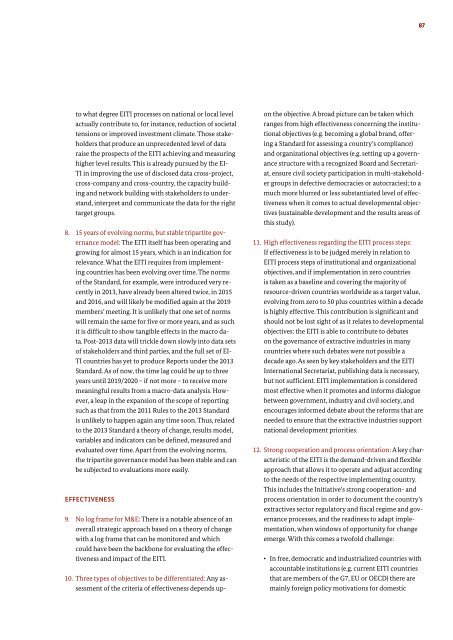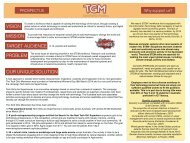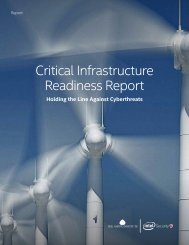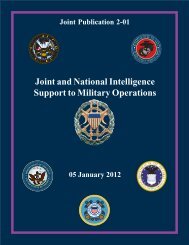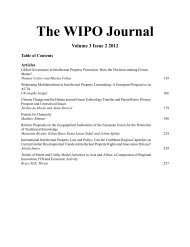Transparency Initiative (EITI)
2eoch1l
2eoch1l
Create successful ePaper yourself
Turn your PDF publications into a flip-book with our unique Google optimized e-Paper software.
87<br />
to what degree <strong>EITI</strong> processes on national or local level<br />
actually contribute to, for instance, reduction of societal<br />
tensions or improved investment climate. Those stakeholders<br />
that produce an unprecedented level of data<br />
raise the prospects of the <strong>EITI</strong> achieving and measuring<br />
higher level results. This is already pursued by the EI-<br />
TI in improving the use of disclosed data cross-project,<br />
cross-company and cross-country, the capacity building<br />
and network building with stakeholders to understand,<br />
interpret and communicate the data for the right<br />
target groups.<br />
8. 15 years of evolving norms, but stable tripartite governance<br />
model: The <strong>EITI</strong> itself has been operating and<br />
growing for almost 15 years, which is an indication for<br />
relevance. What the <strong>EITI</strong> requires from implementing<br />
countries has been evolving over time. The norms<br />
of the Standard, for example, were introduced very recently<br />
in 2013, have already been altered twice, in 2015<br />
and 2016, and will likely be modified again at the 2019<br />
members’ meeting. It is unlikely that one set of norms<br />
will remain the same for five or more years, and as such<br />
it is difficult to show tangible effects in the macro data.<br />
Post-2013 data will trickle down slowly into data sets<br />
of stakeholders and third parties, and the full set of EI-<br />
TI countries has yet to produce Reports under the 2013<br />
Standard. As of now, the time lag could be up to three<br />
years until 2019/2020 – if not more – to receive more<br />
meaningful results from a macro-data analysis. However,<br />
a leap in the expansion of the scope of reporting<br />
such as that from the 2011 Rules to the 2013 Standard<br />
is unlikely to happen again any time soon. Thus, related<br />
to the 2013 Standard a theory of change, results model,<br />
variables and indicators can be defined, measured and<br />
evaluated over time. Apart from the evolving norms,<br />
the tripartite governance model has been stable and can<br />
be subjected to evaluations more easily.<br />
EFFECTIVENESS<br />
9. No log frame for M&E: There is a notable absence of an<br />
overall strategic approach based on a theory of change<br />
with a log frame that can be monitored and which<br />
could have been the backbone for evaluating the effectiveness<br />
and impact of the <strong>EITI</strong>.<br />
10. Three types of objectives to be differentiated: Any assessment<br />
of the criteria of effectiveness depends upon<br />
the objective. A broad picture can be taken which<br />
ranges from high effectiveness concerning the institutional<br />
objectives (e.g. becoming a global brand, offering<br />
a Standard for assessing a country’s compliance)<br />
and organizational objectives (e.g. setting up a governance<br />
structure with a recognized Board and Secretariat,<br />
ensure civil society participation in multi-stakeholder<br />
groups in defective democracies or autocracies); to a<br />
much more blurred or less substantiated level of effectiveness<br />
when it comes to actual developmental objectives<br />
(sustainable development and the results areas of<br />
this study).<br />
11. High effectiveness regarding the <strong>EITI</strong> process steps:<br />
If effectiveness is to be judged merely in relation to<br />
<strong>EITI</strong> process steps of institutional and organizational<br />
objectives, and if implementation in zero countries<br />
is taken as a baseline and covering the majority of<br />
resource-driven countries worldwide as a target value,<br />
evolving from zero to 50 plus countries within a decade<br />
is highly effective. This contribution is significant and<br />
should not be lost sight of as it relates to developmental<br />
objectives: the <strong>EITI</strong> is able to contribute to debates<br />
on the governance of extractive industries in many<br />
countries where such debates were not possible a<br />
decade ago. As seen by key stakeholders and the <strong>EITI</strong><br />
International Secretariat, publishing data is necessary,<br />
but not sufficient. <strong>EITI</strong> implementation is considered<br />
most effective when it promotes and informs dialogue<br />
between government, industry and civil society, and<br />
encourages informed debate about the reforms that are<br />
needed to ensure that the extractive industries support<br />
national development priorities.<br />
12. Strong cooperation and process orientation: A key characteristic<br />
of the <strong>EITI</strong> is the demand-driven and flexible<br />
approach that allows it to operate and adjust according<br />
to the needs of the respective implementing country.<br />
This includes the <strong>Initiative</strong>’s strong cooperation- and<br />
process orientation in order to document the country’s<br />
extractives sector regulatory and fiscal regime and governance<br />
processes, and the readiness to adapt implementation,<br />
when windows of opportunity for change<br />
emerge. With this comes a twofold challenge:<br />
• In free, democratic and industrialized countries with<br />
accountable institutions (e.g. current <strong>EITI</strong> countries<br />
that are members of the G7, EU or OECD) there are<br />
mainly foreign policy motivations for domestic


